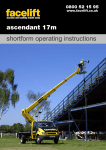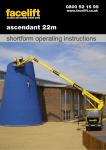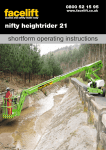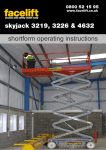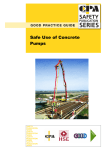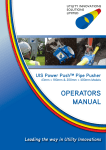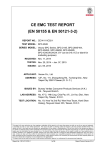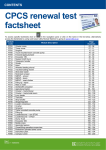Download Pole Ladders User Guide page 1.psd
Transcript
product user guide Title Pole Ladders Issue Date 4 Sept. 2014 Contents Page 1 : Working at Height Regulations 2005, Legislation, References, Page 2 : Component Identification, Safe Use, Ladder Inspection Before and During Use on Site, Ladder Classification, Transportation and Storage on site when not in use, Page 3 : Carrying a Pole Ladder, Erecting and Lowering Pole Ladders, Page 4 : Use of Ladders, Page 5 : Use of Ladders Cont’d, Safety Checklist, General. 1. Working at Height Regulations 2005 The work at height regulations 2005, contains specific requirements for the use of ladders. Regulation 8(e) states that “Every employer shall ensure that, in the case of a ladder, Schedule 6 is complied with.” The parts of Schedule 6 (Requirements for Ladders) applicable to Pole Ladders are as follows :1. Every employer shall ensure that a ladder is used for work at height only if a risk assessment under regulation 3 of the Management Regulations has demonstrated that the use of more suitable work equipment is not justified because of the low risk and - (a) the short duration of use; or (b) existing features on site which he cannot alter. 2. Any surface upon which a ladder rests shall be stable firm, of sufficient strength and of suitable composition to safely support the ladder so that its rungs or steps remain horizontal, and any loading intended to be placed upon it. 3. A ladder shall be so positioned as to ensure its stability during use. 4. A suspended ladder shall be attached in a secure manner and so that, with the exception of a flexible ladder, it cannot be displaced and swinging is prevented. 5. A portable ladder shall be prevented from slipping during use by (a) securing the stiles at or near their upper or lower ends. (b) an effective anti-slip or other stability device; or (c) any other arrangement of equivalent effectiveness. 6. A ladder used for access shall be long enough to protrude sufficiently above the place of landing to which it provides access, unless other measures have been taken to ensure a firm handhold. 7. Where a ladder or run of ladders rises a vertical distance of 9 metres or more above its base, there shall, where reasonably practicable, be provided at suitable intervals sufficient safe landing areas or rest platforms. 8. Every ladder shall be used in such a way that (a) a secure handhold and secure support are always available to the user. (b) the user can maintain a safe handhold when carrying a load. 2. Legislation • The Provision and Use of Work Equipment Regulations 1998 • The Workplace (Health, Safety and Welfare) Regulations 1992 • The Management of Health and Safety at Work Regulations 1999 • The Construction (Health, Safety and Welfare) Regulations 1996 • The Manual Handling Operations Regulations 1992 • The Health and Safety at Work Act 1974 • The Work at Height Regulations 2005 3. References • BS EN 12811 - 1 Scaffolds. Performance Requirements and General Design (Schedule 6) and Good Practice. • CITB Construction Site Safety Module C1 and C2 (May 2005) • HSE paper “Safety in the Selection and Use of Ladders” June 2005 • BLMA Users Guide, May 2005 Page 1 of 5 product user guide Title Issue Pole Ladders Date Sept. 2014 4 4. Component Identification Mabey Hire can provide the following wooden Pole Ladders, details of which are:Code Overall Length (m) No. of Rungs Weight (kg) LADR011P 3 11 19 LADR013P 4 15 23 LADR016P 5 19 29 LADR020P 6 23 38 LADR024P 7 27 40 LADR026P 8 31 47 Rungs ‘L’ 5. Safe Use When used for access to excavations a helpful guide for selecting a minimum ladder length is:Depth of Excavation & Sheet projection above G.L (m) Minimum Ladder Length Req’d (m) 1.0m Min G.L. 1.5 3 2.5 4 3.5 5 4.5 6 5.5 7 6.5 8 Sheet Projection above Ground Level (typ. 0.5m) Excavation Depth These length’s are based on a safe working angle of 75 degrees (4:1) & a projection above the top of the sheet of at least 1.0m (as recommended by C.I.T.B.). 6. Ladder Inspection Before and During Use on Site Ladders are inspected by Mabey Hire before issue to site and a ‘Record of Inspection’ form will be issued with each delivery. Whilst on hire it is the responsibilty of the user / hirer to ensure that the ladder undergoes pre-use checks and detailed and interim inspections as required, depending upon the task, site conditions and duration of hire. Page 5 contains a safety checklist for ladders. Refer to this before first using the ladders and regularly during site usage. 7. Ladder Classification (as advised by the ladder manufacturer) Wooden pole ladders are manufactured to conform to the significant clauses of BS 1129 : 1990 8. Transportation and Storage on site when not in use • Ladders should be stored indoors if possible or covered and stored clear of the ground in a dry, protected, well ventilated area. • Store level on the stiles. • Ensure there are sufficient supports to prevent sagging. Ladders must not be hung from the rungs or stiles. Supports Pole Ladder Ground Clearance Page 2 of 5 product user guide Title Pole Ladders Issue 4 Date Sept. 2014 9. Carrying a Pole Ladder A short ladder may be carried comfortably by having it vertical against the shoulder and holding one of the lower rungs, using the other hand to hold the stile, (see fig A). Longer ladders should be carried horizontally on the shoulders by 2 people, one at either end, (see fig. B). Care should be taken in negotiating corners and obstacles. Ladders should not be taken into the vicinity of overhead power lines unless a permit to work has been issued. Fig. A Fig. B 10. Erecting and Lowering Pole Ladders The procedure for erecting a ladder is as follows :• When the ladder is flat on the ground one person stands on the bottom rung, while the other takes position at the head and takes hold of the top rung, raising the ladder off the ground. • Then, rung by rung, that person moves towards the foot, lifting as he goes. • The person at the foot grasps the lower rungs as soon as possible and draws the ladder towards them, whilst steadying it. • The sequence is reversed when lowering. • Short ladders may be raised by one person, placing the foot of the ladder against a wall or fixture and pushing the ladder from the top. Page 3 of 5 product user guide Title Pole Ladders Issue Date 4 Sept. 2014 11. Use of Ladders 1.0m Minimum • A ladder must not be used as an access to, or egress from, a workplace unless it is reasonable to do so taking into account the work being carried out, its duration, and the risks to the safety of any person arising from the use of the ladder. See schedule 6 of the Work at Height Regulations 2005. • A ladder must be of the correct class for the intended use, of sufficient strength, suitable for the job that is to be done, and be so erected that it does not become displaced. Lashing on Stiles • The ladder should be suited to the purpose for which it is to be used and free from any defects. • Ladders should be set on a firm, level base strong enough to support the ladder and any load that may be placed upon it. There should be no makeshift use of bricks, blocks, timber packs, etc to gain extra height or to level up the stiles. • Ladders should be sited clear of any excavation, and in such a position that they are not causing a hazard, or placed anywhere where they may be struck or dislodged. Barriers should be placed around the foot as added protection where necessary. 75˚ 1 • Ladders must be properly maintained, of sound construction and materials, free from any defects and kept in good repair. If a rung is missing or damaged, the ladder must not be used. • Ladders must be supported on each stile and prevented from sagging or swaying. • Ladders should not be placed so that they are resting against any fragile surface or fitting. • Proprietary stand off devices should be used where the point of rest would otherwise be unsuitable e.g. against plastic gutters. • Ladders should be set as near as possible, at an angle of 75 degrees (1 measure out to 4 measures up) • Ladders must not be secured by their rungs; lashings should be around the stiles, or ladder ties may be used. • When using a ladder, secure handholds and secure support must always be available. • Lashing or clamping, at the mid point of a ladder, may be necessary to prevent sway on ladders which are over 6m high. • A Ladder must not be placed in such a position that any adjacent scaffold tubes interfere with the footing of the person on the ladder. • If the vertical height of a ladder is over 9m, safe landing areas or rest platforms shall be provided at suitable intervals. • Only one person should be on a ladder at any one time. • Always face the ladder when climbing or descending it. • When climbing or descending a ladder, both hands must be kept free for holding onto the ladder, and free of any other items. • Footwear worn by persons using a ladder must be suitable for maintaining a satisfactory grip. • Tools and materials required for work can be carried in a shoulder bag, on a special belt, or be hoisted up or lowered afterward. • Tools not in use should be hooked or otherwise secured to the ladder. • Over-reaching leads to over balancing. The most satisfactory method for working safely on a ladder is for both thighs and hips to be kept between the stiles and one hand always holding the ladder. The working position should be not less than five rungs from the top of the ladder. Page 4 of 5 product user guide Title Pole Ladders Issue Date Sept. 2014 4 11. Use of Ladders Cont’d • The top of the ladder must not be repositioned, by jumping, while standing on rungs. • When a ladder must be left standing after working hours, a board must be lashed between the rungs to prevent unauthorised access. • Ropes or lashings which are used to secure a ladder must be in good condition. • As far as possible, ladders must be placed so that there is adequate space behind each rung for a proper foothold. • Ladders must extend at least 1 metre (approx 5 rungs) above the landing place, unless an alternative, secure handhold is available. • Ladders must not be painted or otherwise treated in any way that would hide or conceal anyy defects. They may be treated with a transparent coating such as varnish, shellac or clear preservative. e. • All ladders should, in the interests of safety, be securely fixed or lashed to prevent slipping, either near the top or, if this is not possible, at the bottom. • HSE research has shown that footing a ladder is not an effective way of stopping it from slipping. As a last resort the the ladder can be footed, refer to HSE guidance for details. Bottom Tie Footing 12. Safety Checklist • • • • • • • • • • • • • • • • • • • Is a ladder the right piece of access equipment to be using? Are ladders only used for very light work of short duration, or access? Are all ladders properly stored and inspected regularly? Are all the ladders which are being used suited to the purpose or use to which they are being put? Are there any damaged, loose or missing parts? Are the rungs and stiles of the ladders clean and free of mud and grease? Are the tie rods beneath the rungs whilst the ladder is in use? Are sufficient persons available to handle and place ladders properly and safely? Are ladders set on firm and on level ground? Are ladders properly erected and secured, so that the ladder projects at least 1.0m above landing place? If there is not an alternative suitable hand-hold, does the ladder project sufficiently above the landing place? Are the methods for raising tools or materials safe? Are the ladders placed so that the work does not involve over - reaching? Is suitable footwear being worn, that will give a satisfactory grip and prevent slipping? Are ladders set at the correct angle of 75 degrees? Are all ladders properly secured or footed at all times? Are ladders clear of excavations or other potential hazards Are ladders being leant against or secured to any fragile material? Are all lashings used of sound material, and made properly secure? 13. General Since our policy is one of continual improvement, components may vary in detail from the descriptions given in this publication. Page 5 of 5






